Reporting Project Performance
|
| < Day Day Up > |
|
Throughout the project, customers and other stakeholders are going to need updates on the project performance. Performance reporting is the process of collecting, organizing, and disseminating information on how the project resources are being used to complete the project objectives. In other words, the people footing the bill and affected by the outcome of the project need some confirmation that things are going the way the project manager has promised.
Performance reporting covers more than just cost and schedule, though these are the most common concerns. Another huge concern is the influence of risks on the project success. The project manager and the project team must continue to monitor and evaluate risks, including pending risks and their impact on the project success.
Finally, another major issue with reporting is the level of quality. No one will praise the project manager and the project team for completing the project on time and on budget if the quality of the work is unacceptable. In fact, the project could be declared a failure and cancelled as a result of poor quality, or the project team would have to redo the work, business could be lost, or individuals could even harmed as a result of the poor quality of the project work.
Performance reporting involves six things:
-
Status reports How’s the project right now?
-
Progress reports How complete is the project? How much more work remains?
-
Forecasting Will this project end on schedule? Will the project be on budget? How much longer will this project take? And how much more money will this project need to finish?
-
Scope How is the project meeting the project scope?
-
Quality What are the results of quality audit, testing, and analysis?
-
Risks What risks have come into the project and what has been their affect on the project?
Preparing for Performance Reporting
The project plan is one of the key inputs to performance reporting. The project plan contains the WBS, the project scope and requirements, and other documentation that can be used to measure project progress and performance.
Other inputs to performance reporting are the work results. Work results can be examined and measured for quality, time spent completing the work, and the monies required to complete the work results. The work results, as progress reports or completion of work results, can be measured against the estimates and expectations to reveal variances. The Communications Management Plan will detail how values are measured, for example EVM, and at what point variances call for communications to the appropriate stakeholders.
The last inputs to performance reporting are other project records, such as memos, product description, and other information relevant to the project. For example, a customer may request project status updates every quarter, regardless of where the project is in its timeline. Or a project may have multiple vendors whose contracts require differing levels and types of reporting from the project staff. This is a communication requirement that would be in the Communications Management Plan.
Reviewing Project Performance
The project manager will host performance review meetings to ascertain the progress and level of success the project team is having with the project work. Performance review meetings focus on the work that has been completed and how the work results are living up to the time and cost estimates. In addition, the project manager and the project team will evaluate the project scope to protect it from change and creep. The project manager and the project team will also examine quality and its affect on the project as a whole. Finally, the project manager must lead a discussion on pending or past risks and determine any new risks and overall risk likelihood and impact on the project’s success.
Analyzing Project Variances
Performance review meetings are not the only tools the project manager uses to assess project performance. Prior to the performance reviews, or spurred by a performance review, the project manager needs to examine the time, scope, quality and cost variances within the project. The project manager will examine the estimates supplied for the time and cost of activities and compare it to the time and cost actually experienced.
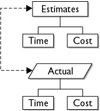
The goals of analyzing project variances are:
-
Prevent future variances
-
Determine the root cause of variances
-
Determine if the variances are an anomaly or if the estimates were flawed
-
Determine if the variances are within a predetermine acceptable range, such as negative ten percent or plus five percent
-
Determine if the variances can be expected on future project work
In addition to examining the time and cost variances, which are the most common, the project manager must also examine any scope, resource, and quality variances. A change in the scope can skew time and cost predictions. A variance in resources, such as the expected performance by a given resource, can alter the project schedule and even the predicted costs of a project. Quality variances may result in rework, lost time, lost monies, and even rejection of the project product.
Completing Trend Analysis
Picture this: you’re a project manager for a long-term project. You’d like to examine how performance has been for the past few years to predict how the upcoming performance will be expected. You’re doing trend analysis. Trend analysis is an approach of studying trends within past performance to predict what upcoming experiences may be like. Trend analysis is great for long projects, analysis of team performance, and predicting future activities.
Using Earned Value Analysis
Remember Earned Value from Chapter 7? Earned Value, in case you were eager for Chapter 10 and flew past Chapter 7, is the basis of a common approach to performance measurement. It is a series of formulas that can reveal cost and time variances and can predict what may happen in the remaining portion of the project. Figure 10-3 provides a recap of earned value.
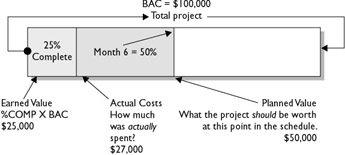
Figure 10-3: Earned Value can show and predict project performance.
| On the Job | EV is not the most common approach to performance measurement. It is, however, being widely used in government projects. More and more commercial projects are adapting the approach. |

Variances
At the end of the project will there be a budget variance (VAR)? Any variance at the end of the project is calculated by subtracting the Actual Costs (AC) of the project work from the Budget at Completion (BAC). Throughout the project, however, a variance is any result that is different from what planned or expected.
Earned Value
Earned Value (EV) is the work that has been accomplished within the project plus the authorized budget for the work that has been accomplished. There are several methods to calculate the EV of the project work, but the most common method is the percentage of the work completed multiplied by the budget at completion (BAC). For example, if a project has a budget of $200,000 and ten percent of the work is complete, the EV is $20,000.
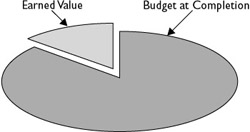
Cost Variances
The Cost Variance (CV) is the difference between the Earned Value and the Actual Costs (AC). For example, for a project that has a budget of $200,000 and has earned or completed ten percent of the project value, the EV is $20,000. However, due to some unforeseen incidents, the project manager had to spend $25,000 to complete that $20,000 worth of work. The AC of the project, at this point, is $25,000. The Cost Variance is $5,000. The equation for Cost Variance is: CV = EV–AC.

Schedule Variances
A Schedule Variance (SV) is the value that represents the difference between where the project was planned to be at a point in time and where the project actually is. For example, consider a project with a budget of $200,000 that’s expected to last two years. At the end of year one, the project team has planned the project to be 60 percent complete. The Planned Value (PV), then, for 60 percent completion equates to $120,000—the expected worth of the project work at the end of year one. At the end of year one, however, the project is only 40 percent complete. The EV at the end of year one is, therefore, $80,000. The difference between the PV and the EV is the SV: $40,000. The equation for Schedule Variance is: SV = EV–PV.
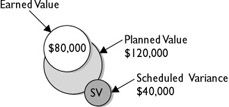
Cost Performance Index
The Cost Performance Index (CPI) shows the amount of work the project is completing per dollar spent on the project. In other words, a CPI of .93 means it is costing $1.00 for every 93 cent’s worth of work. Or you could say the project is losing seven cents on every dollar spent on the project. In our example, the project has an EV of $20,000 and an AC of $25,000. The CPI for this project is .80. The closer the number is to 1, the better the project is doing. The equation for Cost Performance Index is: CPI = EV/AC.
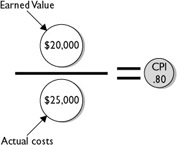
Schedule Performance Index
The Schedule Performance Index (SPI) is very similar to the CPI. The SPI, however, reveals how closely the project is on schedule. Again, the closer the quotient is to 1 the better. The formula is EV divided by the PV. In our example, the EV is $20,000, and let’s say the PV, where the project is supposed to be, is calculated as $30,000. The SPI for this project is .67—way off target! The equation for Schedule Performance Index is: SPI = EV/PV.
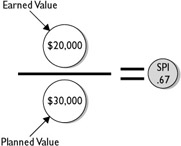
Estimate at Completion
The Estimate at Completion (EAC) is a prediction of what the final project cost will be based on experiences in the project so far. There are several different formulas to calculate the EAC, all of which are included in Chapter 7. For now, and for the exam, here’s the EAC formula you’ll need to know: EAC = BAC/CPI. In our project, the BAC is $200,000. The CPI was calculated to be .80. The EAC for this project is $250,000.
Exam Watch
Here are a couple of index tips. EV comes first in any formula where it’s used (those for CV, SV, CPI, and SPI). A variance is a subtraction problem; an index is a division problem. Also, pay close attention to the decimal point in the answer. A choice without the decimal is wrong; in other words “87” and “.87” are not the same.
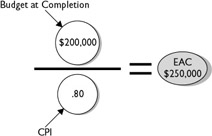
Estimate to Complete
The Estimate to Complete (ETC) shows how much more money will be needed to complete the project. It’s a straightforward formula: EAC–AC. Our EAC was calculated to be $250,000, and let’s say our AC is $25,000; our ETC would then be $225,000.
Variance at Completion
Whenever you talk about variances it’s the difference between what was expected and what was experienced. The formula for the Variance at Completion (VAC) is VAC = BAC–EAC. In our example, the BAC was $200,000, and the EAC was $250,000, so the VAC is predicted to be $50,000.
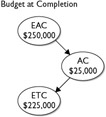
EV and Communications
Based on the results of earned value analysis, a communication to management may be required. A common approach is through a method called a bull’s eye. The bull’s eye approach creates limits to what would be acceptable earned values. Any variances that exceed these limits automatically prompts a communication to management. Figure 10-4 is a sample bull’s eye.

Figure 10-4: A bull’s eye can determine when communication to management is required.
Exam Watch
Memorize the EVM formulas. You’ll encounter a handful of questions on the PMP exam dealing with EVM. You should, without a doubt, get every one of the EVM questions correct. Create a mnemonic device to remember the formulas.
Here are five rules to remember the EVM formulas:
-
Always start with EV.
-
Variance means subtraction.
-
Index means division.
-
Less than 1 is bad in an index.
-
Negative is bad in a variance.
The formulas for earned value analysis can be completed manually or through project management software. For the exam, you’ll want to memorize these formulas. The table below is a summary of all the formulas and a sample, albeit goofy, mnemonic device.
| Name | Formula | Sample Mnemonic Device |
|---|---|---|
| Variance | VAR=BAC–AC | Victor |
| Earned Value | EV=%complete X BAC | Eats |
| Cost Variance | CV=EV–AC | Carl’s |
| Schedule Variance | SV=EV–PV | Sugar |
| Cost Performance Index | CPI=EV/AC | Corn |
| Schedule Performance Index | SPI=EV/PV | S (These three spell “SEE”) |
| Estimate at Completion | EAC=BAC/CPI | E |
| Estimate to Complete | ETC=EAC–AC | E |
| Variance at Completion | VAC=BAC–EAC | Victor |
Examining the Results of Performance Reporting
The goal of performance reporting is to share information regarding the project performance with the appropriate stakeholders. Of course, performance reporting is not something done only at the end of the project or after a project phase, but is rather done on a regular schedule, as detailed in the communication plan, or as project conditions warrant. Outputs of performance reporting include:
-
Performance reports These are the results and summation of the project performance analysis. The Communications Management Plan will detail the type of report needed based on the conditions within the project, the timing of the communication, and the demands of the project stakeholder.
-
Change requests Results of performance may prompt change requests to some area of the project. The change requests should flow into the change control system for consideration and approval or denial.
Performance reports and change requests are an input to the following Change Control Processes:
-
Integrated Change Control
-
Scope Change Control
-
Schedule Change Control
-
Cost Change Control
|
| < Day Day Up > |
|
EAN: 2147483647
Pages: 209